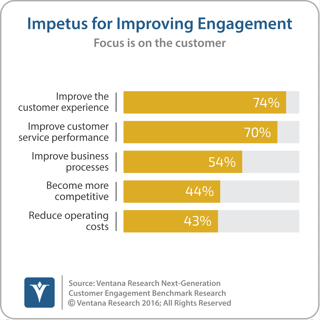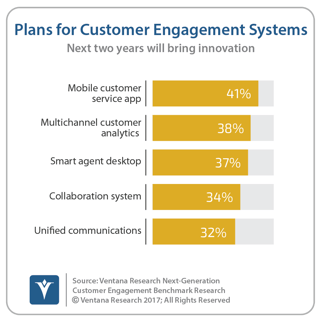Our benchmark research into next-generation customer engagement finds that three- quarters (77%) of organizations participating in the research said it is very important to improve the way they engage with customers. The two main drivers behind this are improving the customer experience (cited by 74%) and improving performance of the customer service organization (70%). This is important because most companies said their customers have good experiences, but only one-third said that experience is excellent.
quarters (77%) of organizations participating in the research said it is very important to improve the way they engage with customers. The two main drivers behind this are improving the customer experience (cited by 74%) and improving performance of the customer service organization (70%). This is important because most companies said their customers have good experiences, but only one-third said that experience is excellent.
Several issues are impacting the way organizations engage with customers, among them inconsistency handling interactions and conforming with external regulations (each a problem for 13% of companies), followed by the inability to collaborate internally (10%), as well as ineffective processes and lack of a single source of customer data (both 9%). Taken together, these issues highlight organizations’ need to find ways to ensure interactions are handled consistently, regardless of channel, whether an employee or self-service technology handles the interaction.
The research suggests that achieving this consistency will be difficult for two primary reasons – the increasing number of channels organizations must support and the widening range of employees handling interactions. The research finds that, with the notable exception of IT, employees in almost all business groups handle interactions. These include employees from several divisions within the organization, including the contact center (in 71% of organizations), sales (59%), branch offices (50%), dedicated customer service (43%), finance (30%) and HR (23%). In addition, one in three organizations handle interactions with mobile workers and one in four with home-based agents; the research indicates that both these roles’ involvement in customer interactions will grow more than 10 percent in the next 12 months. This diversification puts pressure on organizations to establish processes so that customers receive consistent responses.
The research also finds that, in order to meet customer expectations, organizations are aligning their system implementation plans to more closely match emerging systems they expect to improve customer experience, rather than the systems they currently deploy. The systems most commonly in place are CRM (40%), performance management (44%), business process management (43%), web-based self-service (39%) and contact center analytics (36%). Going forward, the research shows the top actions organizations said will improve the customer experience are to deploy a collaboration system (the first choice for 16% of organizations), redesign the corporate portal and deploy a mobile app (each at 12%). The first enables employees to collaborate on interactions, and the other two address customer expectations for the channels they are most likely to use. The research shows that companies said they plan to augment conventional collaboration tools such as file sharing and instant messaging with Facebook-like capabilities, enabling unified communications and collaborative coaching.
 To meet these objectives, the systems companies most often intend to implement in the next 24 months are a mobile customer service app (planned by 41%), multichannel analytics (36%), a smart agent desktop (37%), a collaboration system (34%) and unified communications (32%). Four of these closely align with the systems organizations cited as having the most impact on customer experience, with the exception of a smart desktop. Regarding the last, we believe that such systems allow organizations to integrate on a single desktop all the systems and information employees need to handle interaction and present them in ways that are easy to use. This will allow more employees to handle more types of interactions, improve the efficiency and effectiveness of interaction handling and increase employee satisfaction. We see a stark contrast between systems already deployed and systems organizations plan to deploy; for example, CRM drops from top of the list to the fourth-lowest, as less than one-quarter (23%) of companies said they plan to deploy such a system.
To meet these objectives, the systems companies most often intend to implement in the next 24 months are a mobile customer service app (planned by 41%), multichannel analytics (36%), a smart agent desktop (37%), a collaboration system (34%) and unified communications (32%). Four of these closely align with the systems organizations cited as having the most impact on customer experience, with the exception of a smart desktop. Regarding the last, we believe that such systems allow organizations to integrate on a single desktop all the systems and information employees need to handle interaction and present them in ways that are easy to use. This will allow more employees to handle more types of interactions, improve the efficiency and effectiveness of interaction handling and increase employee satisfaction. We see a stark contrast between systems already deployed and systems organizations plan to deploy; for example, CRM drops from top of the list to the fourth-lowest, as less than one-quarter (23%) of companies said they plan to deploy such a system.
Citing benefits of these and other systems already in place, three out of five companies said they have improved customer service, and nearly half said they have increased customer satisfaction. In contrast, only 22 percent have improved customer effort scores, and just 16 percent have improved net promoter scores, again showing a lack of focus on these more innovative measures.
When organizations evaluate products and vendors to supply these new systems, they view the most pertinent criteria as functionality (very important to 53%), usability (49%) and reliability (46%). Both consumers and the younger generation of employees who appreciate technology expect that systems will be both feature-rich and easy to use. We anticipate therefore that potential buyers will demand the same of vendors, especially as business units have taken more purchase responsibilities from IT groups.
It is clear from our research that no one system can deliver optimal customer experiences. Achieving this goal requires a combination of business systems – such as CRM, systems that manage assisted and digital channels of engagement, systems such as workforce optimization that manage the people-side of handling interactions and analytics – that give a clear picture of how interaction handling is working and identify areas for improvement. Our research shows that organizations are on the right track, but only time will tell how many make the people and process changes they need to gain the full benefits of the systems they implement, and whether in combination these systems help companies deliver on the “CX promise.”
Regards,
Richard Snow
VP & Research Director, Customer Engagement
Follow Me on Twitter and Connect with me on LinkedIn











